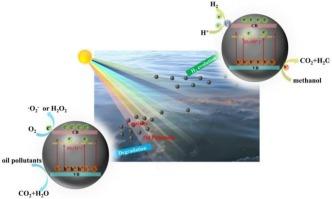Floating black TiO2-HGMs (hollow glass microspheres) with tunable defects for boosted seawater splitting and petroleum pollutants degradation
IF 4.9
3区 环境科学与生态学
Q1 ENVIRONMENTAL SCIENCES
引用次数: 0
Abstract
Developing photocatalytic materials with both recyclability and high activity has been a challenging task that has garnered increasing attention. In order to address this challenge, the black TiO2 coated on the surface of hollow glass microsphere (HGMs) was prepared by using a facile sol-gel method and NaBH4 solid-state reduction. Ti3+ and oxygen vacancies with tunable defects can be introduced by adjusting the amount of NaBH4, which can not only enhance the absorption of visible light, but also improve the separation efficiency of photo-generated carriers. The as-prepared black TiO2/HGMs manifested excellent recyclability and high photocatalytic activity in splitting seawater for H2 evolution and degradation of diesel pollutants. Its hydrogen evolution rate and degradation efficiency are increased by 2.5 times and 1.3 times respectively compared to white TiO2/HGMs and possess excellent cycling stability. Electron paramagnetic resonance (EPR), X-ray photoelectron spectroscopy(XPS) and band gap analysis reveal the reason for the excellent photocatalytic performance of black TiO2/HGMs. This study offers a unique approach for designing and preparing high-performance photocatalysts that can be easily recycled, which has potential applications in the environmental restoration and energy conversion fields.

具有可调缺陷的悬浮黑色二氧化钛- hgms(中空玻璃微球)用于促进海水分裂和石油污染物降解
开发具有可回收性和高活性的光催化材料是一项具有挑战性的任务,已引起越来越多的关注。为了解决这一难题,采用溶胶-凝胶法和NaBH4固态还原法制备了涂覆在中空玻璃微球(HGMs)表面的黑色TiO2。通过调节NaBH4的用量,可以引入具有可调缺陷的Ti3+和氧空位,不仅可以增强可见光的吸收,还可以提高光生载流子的分离效率。制备的黑色TiO2/HGMs具有良好的可回收性,在分解海水析氢和降解柴油污染物方面具有较高的光催化活性。与白色TiO2/HGMs相比,其析氢速率和降解效率分别提高了2.5倍和1.3倍,并具有良好的循环稳定性。电子顺磁共振(EPR)、x射线光电子能谱(XPS)和带隙分析揭示了黑色TiO2/HGMs具有优异光催化性能的原因。本研究为设计和制备易于回收的高性能光催化剂提供了一种独特的方法,在环境修复和能量转换领域具有潜在的应用前景。
本文章由计算机程序翻译,如有差异,请以英文原文为准。
求助全文
约1分钟内获得全文
求助全文
来源期刊

Marine pollution bulletin
环境科学-海洋与淡水生物学
CiteScore
10.20
自引率
15.50%
发文量
1077
审稿时长
68 days
期刊介绍:
Marine Pollution Bulletin is concerned with the rational use of maritime and marine resources in estuaries, the seas and oceans, as well as with documenting marine pollution and introducing new forms of measurement and analysis. A wide range of topics are discussed as news, comment, reviews and research reports, not only on effluent disposal and pollution control, but also on the management, economic aspects and protection of the marine environment in general.
 求助内容:
求助内容: 应助结果提醒方式:
应助结果提醒方式:


